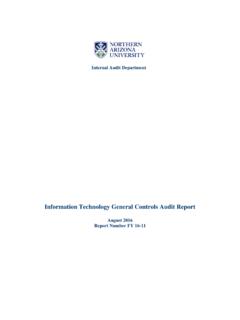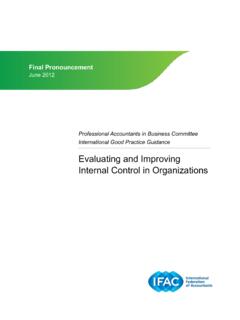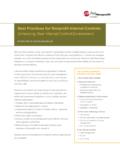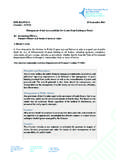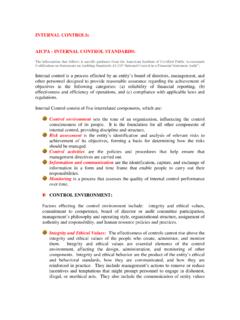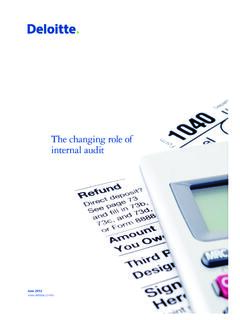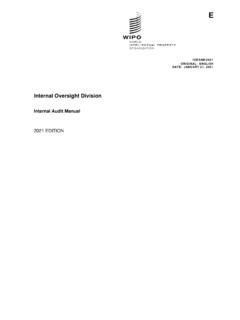Transcription of Best Practices for Elevating Your Accounts Payable ...
1 Best Practices for Elevating Your Accounts Payable Internal Controls and Compliance Program Sponsored byAn AP & P2P white paper2 TABLE OF CONTENTSI ntroduction ..3 What are the Roles of the CFO and Controller? ..4 Who is Responsible for Financial Compliance and Internal Controls? ..4 The Three Critical Corporate Controls to Achieve Best-in-Class AP Compliance ..4 The Supplier Onboarding Process ..6 Detecting and Preventing Accounts Payable Fraud ..8 Managing the Risk: Internal control Process for the Accounts Payable Record to Report (R2R) Process ..9 Addendum 1: Summary of Best Practices ..11 Addendum 2: Comprehensive Compliance Guide ..12 Best Practices for Elevating Your Accounts Payable Internal Controls and Compliance Program 2016 IOFM, Diversi ed Communications.
2 No part of this publication may be reproduced, stored in a retrieval system or transmitted by any means, electronic or mechanical, without prior written permission of the Institute of Finance & Management. 3 IntroductionThe AP Department plays a critical role within an organization. As a governing entity in the supplier sourcing process, it ensures that each supplier is properly screened prior to onboarding, thereby protecting the company from risk due to fraud, nes, audits, and investigations. Once a supplier relationship is established, the AP Department continues to protect the company s nancial interests by ensuring timely invoice processing, verifying that payments are made according to agreed-upon terms, and providing a high level of customer service.
3 Last but not least, Accounts Payable also serves as the last point of control before a payment is sent to a supplier. Once money is sent to a supplier, your chances of retrieving these funds at a later date due to an unintended data entry error or due to fraud by an employee or supplier are extremely low. The right approval work ows, signatory rights, and processes must be proactively established to minimize the likelihood of this also supports the integrity of the supplier master le within the Procure to Pay (P2P) process and the integrity of the nancial transaction through the nancial close or the Record to Report (R2R) process. Error-prone and delayed payment reconciliation processes raise red ags that can lead to nancial reporting errors and their crucial role in the business, Accounts Payable processes are subject to compliance requirements and internal controls that can be complicated and overwhelming.
4 Companies that operationalize best Practices into their AP processes and monitor them with internal control systems can manage the complexity, prevent transactional or closing problems, and consistently maintain the integrity of their corporate whitepaper will put you on a path to establish a best-in-class compliance and internal controls program for your AP Department. It includes requirements and recommended best Practices , along with roles and responsibilities for their implementation. stored in a retrieval system or transmitted by any means, electronic or mechanical, without prior written permission of the Institute of Finance & Management. Best Practices for Elevating Your Accounts Payable Internal Controls and Compliance Program 2016 IOFM, Diversi ed Communications.
5 No part of this publication may be reproduced, stored in a retrieval system or transmitted by any means, electronic or mechanical, without prior written permission of the Institute of Finance & Management. 4 What are the Roles of the CFO and Controller?The CFO and Controller play four vital roles in establishing a compliance and internal controls program. They are:Stewards: CFOs and Controllers protect and preserve the assets of the organization by establishing strong controls, complying with regulations, and preventing : They balance capabilities, costs, and service levels to ful ll the nance organization's responsibilities in a controlled : They provide nancial leadership in determining strategic business direction and align nancial strategies with minimal risk.
6 Catalysts: They stimulate behaviors across the organization to achieve strategic and nancial objectives with strong is Responsible for Financial Compliance and Internal Controls? A company s emphasis on internal nancial control and compliance starts with its tone at the top, the ethical atmosphere that is created in the workplace by the organization's leadership. The tone set by management has a trickle-down effect on both the employees and suppliers of the company. If managers emphasize ethics and integrity, employees and suppliers will be more inclined to uphold the same values. The Three Critical Corporate Controls to Achieve Best-in-Class AP ComplianceThere are three critical corporate controls ( core controls ):1. Segregation of Duties (SoD)2.
7 Systems Access (SA)3. Delegation of Authority (DoA)The Segregation of Duties (SoD)The Segregation of Duties (SoD) control is one of the most important controls that your company can have. Adequate segregation of duties reduces the likelihood that errors (intentional or unintentional) will remain undetected by providing for separate processing by different individuals at various stages of a transaction and for independent reviews of the work Best Practice (1 of 7): Integrate ethics and compliance requirements into all business processes to ensure that the tone at the top is embedded throughout the organization. Speci cally as it relates to Accounts Payable nancial controls, fraud prevention, and tax and regulatory compliance, the of ce of the CFO is responsible for establishing these guardrails and expectations for that function.
8 This approach establishes a corporate environment of internal controls and compliance that extends to the Accounts Payable organization, including supplier management. These initiatives typically include the deployment of ethical standards or a code of conduct for the organization. This is also a requirement for Sarbanes Oxley is Responsible: Financial Executive Staff and Ethics Of cer for implementation and all Company Employees for in a retrieval system or transmitted by any means, electronic or mechanical, without prior written permission of the Institute of Finance & Management. Best Practices for Elevating Your Accounts Payable Internal Controls and Compliance Program 2016 IOFM, Diversi ed Communications. No part of this publication may be reproduced, stored in a retrieval system or transmitted by any means, electronic or mechanical, without prior written permission of the Institute of Finance & Management.
9 5 The SoD control provides four primary bene ts:1. the risk of a deliberate fraud is mitigated as the collusion of two or more persons would be required in order to circumvent controls2. the risk of legitimate errors is mitigated as the likelihood of detection is increased3. the cost of corrective actions is mitigated as errors are generally detected relatively earlier in their lifecycle4. the organization s reputation for integrity and quality is enhanced through a system of checks and SoD is a basic key internal control , its often one of the most dif cult to accomplish due to limited headcount, broadly de ned responsibilities, and constantly changing responsibilities. Basically, the general duties to be segregated are: planning/initiation, authorization, custody of assets, and recording or reporting of , control tasks such as review, audit, and reconcile should not be performed by the same individual responsible for recording or reporting the AccessSystems automation can play a crucial role in establishing, simplifying, and monitoring all three of the core controls, particularly role-based system access and activity logging.
10 Many companies experience lapses in control due to their reliance on manual processes, or experience vulnerabilities in the transfer of data from one system to another. Human beings make mistakes, but a system of checks and balances can mitigate the risk of fraud or of AuthorityIn an automated Delegation of Authority (DoA) process, supplier onboarding, invoice and payments approval are all linked to the company s DoA Policy and the employee Master le and is automated based on de ned work ow rules. The work ow determines: (1) if a supplier / invoice / payment needs approval; (2) who the appropriate approvers are, and; (3) in what order payments should be approved according to established company rules. The work ow will then sequentially ask each approver via a generated email to electronically approve invoices and also payments.
